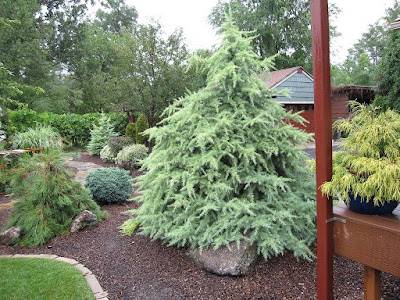Cedrus deodara is found from East Afghanistan (Hindu Kush), NorthWest Pakistan (Karakoram), China (extreme Tibet, Kashmir to West Nepal). It grows in a belt at elevations between 1700 m and 3000 m in the western part of its range and between 1300 m and 3300 m in the eastern part. It is hardy to USDA Hardiness Zone 7 to 9.
Cedrus deodara also called as Deodar cedar, Himalayan cedar, is a species of the genus Cedrus. This species was described by George Don in 1830. The botanical name derives from the Sanskrit term devadāru, which means "wood of the gods", a compound of deva "god" and dāru "wood and tree".
IDENTIFY CEDRUS DEODARA - DEODAR CEDAR PLANTS
Cedrus deodara is found from East Afghanistan (Hindu Kush), NorthWest Pakistan (Karakoram), China (extreme Tibet, Kashmir to West Nepal). It grows in a belt at elevations between 1700 m and 3000 m in the western part of its range and between 1300 m and 3300 m in the eastern part. It is hardy to USDA Hardiness Zone 7 to 9.
Deodar cedar is a large evergreen coniferous tree which reaching to 60 m tall, to 3 m in diameter trunk with dark gray bark and conic crown with level branches and drooping branchlets. The long branchlets usually pendulous, pale grayish yellow and densely pubescent with some white powder in 1st year, thereafter grayish. The leaves in apparent fascicles of 15-20 on short branchlets, initially pale green, aging dark green, linear but broader distally, triangular in cross section, 2.5-5 cm × 1-1.5 mm. Seed cones shortly pedunculate, pale green, initially with some white powder, becoming reddish brown when ripe, ovoid or broadly ellipsoid, 7-12 × 5-9 cm.
Some varieties: Var. viridis - Green Deodar Cedrus (a form with the foliage of deeper green), Var. argentea (foliage silvery-white), Var. aurea - Golden Deodar Cedrus (foliage yellow), Var. robusta - Longleaf Deodar Cedrus (stouter branches and more rigid leaves about 2 inches long).
Himalayan cedar is widely grown as an ornamental tree, often planted in parks and large gardens for its drooping foliage. Its wood is highly valuable and extensively used for building, railway sleepers, carriage and railway wagon work and other purposes for which durability is required. It is used in house building, beams, floorboards, door and window frames, furniture and general carpentry. It also produces quality plywood. A fragrant oil can be distilled from wood chips and sawdust.
CEDRUS DEODARA - DEODAR CEDAR PLANTS CARE AND CULTIVATION
The cultivation of these plants presents no special difficulties, if proper soil and exposure are available. The question of hardiness is, of course, all-important. It is not only the problem of temperature the given tree will stand, but also the exposure to winds, and, to a considerable extent, the source from which the tree is derived. If the plants are raised from seeds matured in similar or even more rigorous climates, they are usually more hardy.
Soils:
Cedrus deodara prefer a well-drained porous gravelly subsoil, overlaid with a light sandy loam. They seem to be particularly happy in a soil underlaid with a porous glacial drift. In cultivation, however, they succeed very well in ordinary well-drained soil. When the plants are set in clay soil, which is often done, the soil should be thoroughly loosened by trenching or subsoil plowing, and well underdrained. Any available humus, woodashes, and well-rotted manure incorporated in the soil greatly aid in rendering it friable and porous for the roots.
Manures and mulches:
Mulching with ordinary well-rotted barnyard manure in late autumn affords much stimulus to growth. By the following spring the manure will be in a desiccated condition and can be incorporated with the soil. A heavy mulch of old straw, rotten hay, or any similar material over the roots, and this was maintained throughout the entire growing season is benefit to the plants in a more or less juvenile condition.
In many cases manure is not obtainable. In such event, newly moved plants should be heavily mulched with rotten straw, rotten hay, or any similar rubbish for a few years until they become established. The frequent stirring of the ground over the roots subsequently will conserve sufficient moisture.
An area extending from the stem to one to two feet beyond the branches, stirred up with hoe and rake perhaps five or six times throughout the growing season, is very beneficial in conserving the moisture around the roots.
Pruning:
Removal of the lower branches of Deodar Cedar is a serious mistake, and, if healthy, they should be retained to the base. Pruning or disbudding can be intelligently performed to add much to the natural symmetry. The extraction or removal, early in spring, of the central or terminal bud, will tend to compel the branches which start from the side buds to spread apart and form a much denser growth. Cutting back the previous year's terminal growth to a strong bud or branchlet on the main limbs over the tree, if the plant is inclined to be thin in its branching, always produces a much denser lateral growth.
Transplanting:
Transplanting can be done at all times of the year, excepting midsummer when they are in full growth. The best success is secured in spring when the buds begin to swell. From the end of August to the middle of September, if there have been abundant rains and the ground has been well soaked, is a very good time to move the plants. They may be planted late in autumn when circumstances compel it, but there is likely to be a considerable percentage of loss. Their roots are very susceptible to injury from exposure to the air, and the utmost vigilance should be exercised to keep them covered and moist.

















COMMENTS